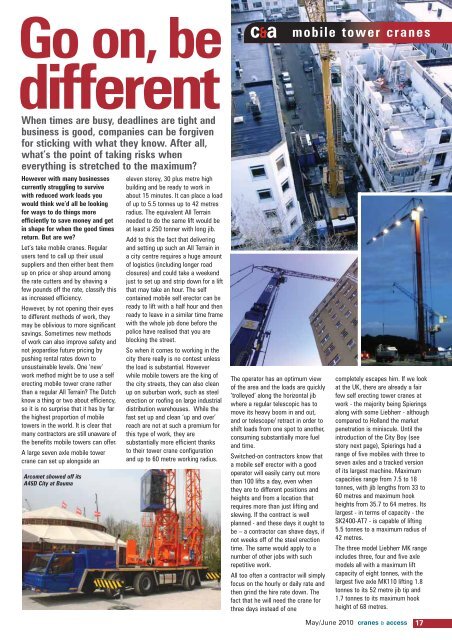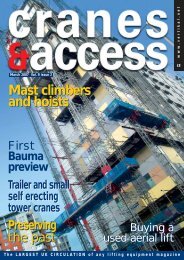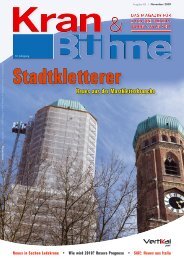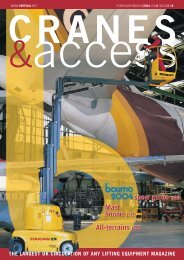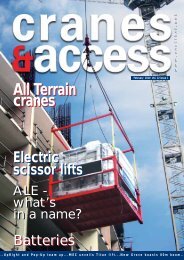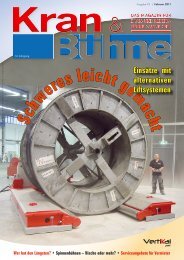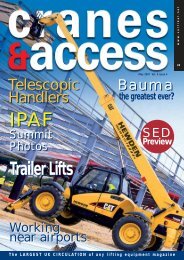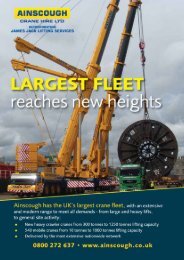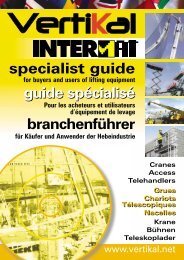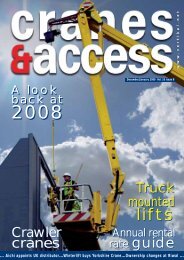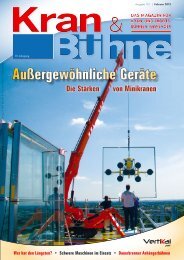Create successful ePaper yourself
Turn your PDF publications into a flip-book with our unique Google optimized e-Paper software.
Go on, be<br />
different<br />
When times are busy, deadlines are tight and<br />
business is good, companies can be forgiven<br />
for sticking with what they know. After all,<br />
what’s the point of taking risks when<br />
everything is stretched to the maximum?<br />
However with many businesses<br />
currently struggling to survive<br />
with reduced work loads you<br />
would think we’d all be looking<br />
for ways to do things more<br />
efficiently to save money and get<br />
in shape for when the good times<br />
return. But are we?<br />
Let’s take mobile cranes. Regular<br />
users tend to call up their usual<br />
suppliers and then either beat them<br />
up on price or shop around among<br />
the rate cutters and by shaving a<br />
few pounds off the rate, classify this<br />
as increased efficiency.<br />
However, by not opening their eyes<br />
to different methods of work, they<br />
may be oblivious to more significant<br />
savings. Sometimes new methods<br />
of work can also improve safety and<br />
not jeopardise future pricing by<br />
pushing rental rates down to<br />
unsustainable levels. One ‘new’<br />
work method might be to use a self<br />
erecting mobile tower crane rather<br />
than a regular All Terrain? The Dutch<br />
know a thing or two about efficiency,<br />
so it is no surprise that it has by far<br />
the highest proportion of mobile<br />
towers in the world. It is clear that<br />
many contractors are still unaware of<br />
the benefits mobile towers can offer.<br />
A large seven axle mobile tower<br />
crane can set up alongside an<br />
Arcomet showed off its<br />
A45D City at Bauma<br />
eleven storey, 30 plus metre high<br />
building and be ready to work in<br />
about 15 minutes. It can place a load<br />
of up to 5.5 tonnes up to 42 metres<br />
radius. The equivalent All Terrain<br />
needed to do the same lift would be<br />
at least a 250 tonner with long jib.<br />
Add to this the fact that delivering<br />
and setting up such an All Terrain in<br />
a city centre requires a huge amount<br />
of logistics (including longer road<br />
closures) and could take a weekend<br />
just to set up and strip down for a lift<br />
that may take an hour. The self<br />
contained mobile self erector can be<br />
ready to lift with a half hour and then<br />
ready to leave in a similar time frame<br />
with the whole job done before the<br />
police have realised that you are<br />
blocking the street.<br />
So when it comes to working in the<br />
city there really is no contest unless<br />
the load is substantial. However<br />
while mobile towers are the king of<br />
the city streets, they can also clean<br />
up on suburban work, such as steel<br />
erection or roofing on large industrial<br />
distribution warehouses. While the<br />
fast set up and clean ‘up and over’<br />
reach are not at such a premium for<br />
this type of work, they are<br />
substantially more efficient thanks<br />
to their tower crane configuration<br />
and up to 60 metre working radius.<br />
c&a<br />
The operator has an optimum view<br />
of the area and the loads are quickly<br />
‘trolleyed’ along the horizontal jib<br />
where a regular telescopic has to<br />
move its heavy boom in and out,<br />
and or telescope/ retract in order to<br />
shift loads from one spot to another,<br />
consuming substantially more fuel<br />
and time.<br />
Switched-on contractors know that<br />
a mobile self erector with a good<br />
operator will easily carry out more<br />
than 100 lifts a day, even when<br />
they are to different positions and<br />
heights and from a location that<br />
requires more than just lifting and<br />
slewing. If the contract is well<br />
planned - and these days it ought to<br />
be – a contractor can shave days, if<br />
not weeks off of the steel erection<br />
time. The same would apply to a<br />
number of other jobs with such<br />
repetitive work.<br />
All too often a contractor will simply<br />
focus on the hourly or daily rate and<br />
then grind the hire rate down. The<br />
fact that he will need the crane for<br />
three days instead of one<br />
mobile tower cranes<br />
completely escapes him. If we look<br />
at the UK, there are already a fair<br />
few self erecting tower cranes at<br />
work - the majority being Spierings<br />
along with some Liebherr - although<br />
compared to Holland the market<br />
penetration is miniscule. Until the<br />
introduction of the City Boy (see<br />
story next page), Spierings had a<br />
range of five mobiles with three to<br />
seven axles and a tracked version<br />
of its largest machine. Maximum<br />
capacities range from 7.5 to 18<br />
tonnes, with jib lengths from 33 to<br />
60 metres and maximum hook<br />
heights from 35.7 to 64 metres. Its<br />
largest - in terms of capacity - the<br />
SK2400-AT7 - is capable of lifting<br />
5.5 tonnes to a maximum radius of<br />
42 metres.<br />
The three model Liebherr MK range<br />
includes three, four and five axle<br />
models all with a maximum lift<br />
capacity of eight tonnes, with the<br />
largest five axle MK110 lifting 1.8<br />
tonnes to its 52 metre jib tip and<br />
1.7 tonnes to its maximum hook<br />
height of 68 metres.<br />
May/June 2010 cranes & access 17


